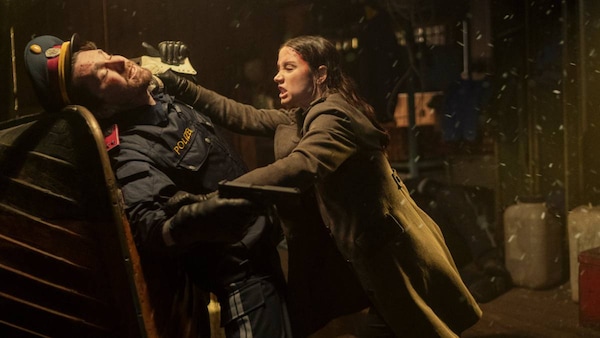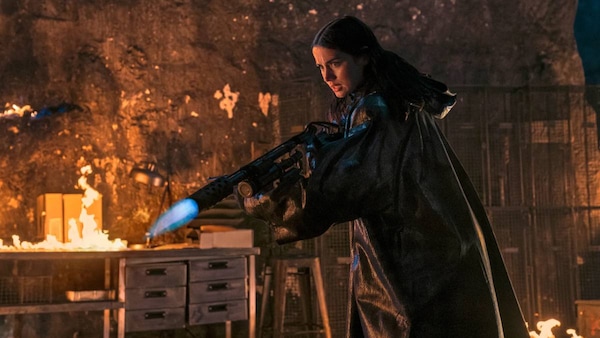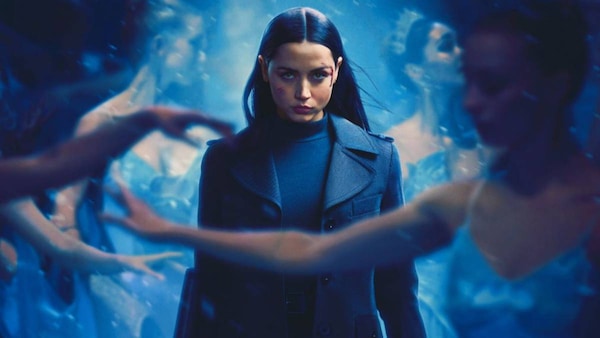From the World of John Wick: Ballerina & The Adrenaline Of Grief
This is #CineFile, where our critic Rahul Desai goes beyond the obvious takes, to dissect movies and shows that are in the news

Last Updated: 01.39 PM, Jun 12, 2025
A SPIN-OFF IN THE John Wick universe, Ballerina stars Ana de Armas as Eve, a young orphan trained by the Ruska Roma — the crime organisation famous for creating Keanu Reeves’ Wick — to be a ballerina-assassin. She is taught to weaponise her intuition and “fight like a girl” instead of trying to defeat men at their own game. She graduates the programme and starts work as a cold-blooded contract killer. But just as she sets out to become the next big Ruska Roma legend, she is overcome by an urge to avenge the murder of her father. All the trauma comes back to her when she identifies an opponent bearing the symbol of the Cult, the outfit responsible for the death of her parents all those years ago. Her ‘mission’ changes.

Ballerina hinges squarely on Armas and her uncanny physicality. There’s something about Eve’s ability to shatter bones, pump bullets and reduce bodies to pulp while at once looking vulnerable. We see her at a stage where she’s yet to be numbed; the broken-assassin cliche is yet to blossom. This isn’t to say she’s conflicted about the ethics of her job, but there’s a humanity about her — a lost girlhood — that makes Eve such an intriguing addition to this franchise. The action pieces lean into this; the sequences often pause to stage the ‘cinema’ and spectacle of her quest. A 30-minute assault in the climax — where Eve takes on an entire snowy town of Cultists in rural Austria — features Armas rocking everything from flamethrowers (burning enemies to a crisp; not stopping until they’re motionless) to giant water hoses to fight the fire. Her only goal is to reach and kill the Chancellor of the Cult — and it’s almost disorienting to watch her absolutely destroy men (and one woman) with such swift remorse.

It’s easy to enjoy the simplicity of revenge in these stories. But the reason this film series continues to slay is because — as John Wick Chapter 4 (2023) demonstrated — the driving force is grief. It’s not a blinding emotion, either. The grief here is what puts the flesh and blood in these machine-like bodies and minds who’ve been trained to suppress themselves. Wick (who’s still alive, because Ballerina is a ‘sidequel’ to the 2019 installment, Parabellum), finds himself empathising with Eve’s desire for revenge. He sees himself in her, of course, but he also recognises that it’s her grief — a survivalist extension of love — that will wake her up to the opportunism of the world that adopted her. Organisations like the Ruska Roma rescue her from others like the Cult, but they also make a choice for her at an early age — and control her fate. As it did with Wick, her solo journey of revenge jolts her out of this assassin-reverie and allows her to go rogue. She puts her skills to use by defying the very people who built her.

The grief of losing her dad, himself a former assassin, is not undone by the years of training; she retains the memory, despite the best efforts of the Ruska Roma (or conversely, the Cult) to quell it beneath a decade of suffering and training. The anguish turns Eve’s cold-bloodedness into something warmer, revealing to her the murky morality of The High Table and their penchant for exploiting the rage of kids who’ve lost everything. She breaks all the rules — like the ‘truce’ between the Ruska Roma and the Cult — to get what she wants. It’s an oddly political tale: a supersoldier breaking free of conditioning and placing personal catharsis over her duty of mindless violence. She pledges her loyalty to herself and nobody else.

The signs of her transformation are subtle. When Eve executes her first contract (where else but a nightclub), she’s dressed in a way that fetishises her gender: subscribing to the sultry stereotype that we’ve come to expect from female-spy productions. But as she sets out on her own, these provocations disappear; she does it on her own terms, divorced from the romanticism and curated sexiness of such characters. She is a woman, but she resists the formulas of being one. Like John Wick himself, she’s dangerous because she has a purpose that transcends her job profile: she’s the one that got away. Her instinct to protect the little girl of an escaped Cult member is natural, too. Eve is liberating the child from the cycle of being co-opted by stylised crime. She wants the girl to have a choice and not just get ‘preyed’ on by an establishment looking for foot soldiers. They call it empowerment, but she reframes it as dehumanisation.

The blueprint (and neat metaphor) of Ballerina lies in the traditional name of Eve: the first woman, the progenitor of humanity, and her expulsion from the Garden of Eden for eating from the Tree of Knowledge. Her original sin here, though, is actually her tool of redemption. Her disobedience is her strength — a courage to deviate from destiny and inject the world with an individualism that faiths are constructed to flatten. It’s no coincidence that ‘John’ is her guide and not the one who punishes her; his existence subverts the very foundation of God and religion. Grief is a forbidden fruit in society because it is often the most unfiltered form of love — a power that is considered to be a form of weakness, an obstruction to the cycle of living. In short, this is a ballerina that isn’t afraid to bleed. Her body reacts, but it’s her heart that yearns.
